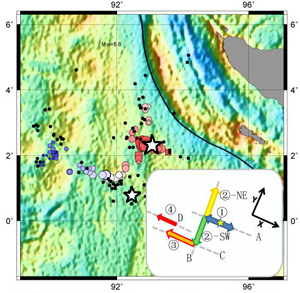The recent magnitude 8.6 earthquake that occurred on April 11, 2012 in the Indian Ocean, far offshore Sumatra, was very different from other "mega-earthquakes." In fact, it broke two records:
- It is the largest strike-slip earthquake ever recorded. (In "strike-slip"earthquakes, land on either side of the fault moves in the horizontal direction, as happens, for example, along the San Andreas fault. Watch an animation of a strike-slip earthquake.)
- It is the largest intra-plate earthquake ever recorded.
-
What's more, its magnitude 8.2 aftershock is the second largest ever recorded.
-
And the rupture followed the most complex path ever imaged by modern seismology, taking some right-angle turns, much as if it were finding its way through a maze.
Mega-earthquakes usually occur at subduction zones, where an oceanic plate is sinking beneath a continental plate, for example, the March 2011 Japan earthquake. (Watch an animation of a subduction zone earthquake.) So it is surprising that this mega-earthquake was strike-slip.
Moreover, it is equally surprising that this mega-earthquake ruptured, not at a plate boundary, but within the subducting oceanic plate. (See a map of plate boundaries.)
Such a large earthquake provides an exceptional opportunity to investigate the physics of such extreme events and to probe the mechanical properties of Earth’s materials deep beneath the oceans, both of which can help with earthquake hazard assessment.
But because of its remote location on the ocean floor, far offshore Sumatra, there were no geophysical monitoring sensors nearby, such as GPS stations.
In spite of the dearth of nearby sensors, scientists were nonetheless able to discover quite surprising details about the earthquake, thanks to a Caltech innovation to the "Back-Projection" technique.
The Caltech group used ground motion recordings by seismometers located around the globe, and coupled these recordings with advanced source imaging techniques developed in Caltech’s Seismolab and Tectonics Observatory by graduate student Lingsen Meng and Assistant Professor Jean-Paul Ampuero. The resulting image and video of the rupture process are seen at the right.
The group found that the earthquake rupture followed an exceptionally tortuous path, breaking multiple segments of a previously unrecognized network of orthogonal (independent) faults. Indeed, a synthesis, by Professor Joann Stock, of seafloor geophysical data available from the region, shows that the rupture did not involve the usual suspect faults. Rather, as it wandered in this maze of faults, the rupture took turns into the apparently darkest alleys, branching into faults that were thought to be mechanically unfavored for rupture. It was the most complex rupture ever imaged by modern seismology.
Not only was the complex path of the rupture unusual, but its large depth was as well. Complementary seismological analysis, by Caltech Seismolab’s postdoctoral fellow Zacharie Duputel and Assistant Professor Victor Tsai, indicates that the rupture reached unusually large depths.
So, what do these puzzling results (the rupture's complex path and large depth) tell us? These observations provide insight into two key inputs for earthquake hazard assessment, the limiting depth of earthquake slip and the possibility of ruptures involving multiple faults. Moreover, when combined with theoretical models of rupture dynamics, these results imply that the strength of deep oceanic rocks is not as sensitive to pressure changes as is the strength of the shallower crust. This in turn has implications on the water cycle deep inside the Earth, which plays a key role in plate tectonics and geodynamics.
|
Video of the rupture propagation over the first three minutes - based on seismic data from Japan networks. The white star is the mainshock epicenter and the green circles are the epicenters of the first day of aftershocks. Time (in seconds) is shown on top. The Sumatra trench and coastline are shown by white curves. [Credit: Caltech/Meng et al.]
Compare the complexity of this rupture with the rupture of the 2004 Sumatra earthquake (Magnitude 9.1), by watching a video of that rupture.
|
|

Bird's eye view of the three stages of the rupture -
The two white stars indicate the epicenters of the main shock (large white star) and the M8.2 aftershock (smaller white star). Other aftershocks are indicated by the black circles. The black line indicates the Sumatra Trench, the boundary between the Pacific Plate (on the left) and the Sumatra Plate. The rupture occurred over at least three distinct stages. It started out as a bilateral rupture (propagating in two, opposite directions, indicated by fault A in inset), rupturing 100 km in about 25 s. It then branched off into a perpendicular fault (fault B) breaking bilaterally here as well for over 300 ft and taking ~60 s. After a pause of about 15 s, the rupture propagated to the Sumatra trench. Fault B's rupture front branched yet again into a third, almost orthogonal fault (fault C) which ruptured for 100 km. The total rupture length is 500 km, half of what scientists expected based on the traditional way of analyzing. The rupture speed remained steady at 2.5 km/s. [Credit: Caltech/Meng et al.] |
|
See Caltech press release
Science article:
Meng, Ampuero, Stock, Duputel, Luo and Tsai, "An earthquake in a maze: compressional rupture branching during the April 11 2012 M8.6 Sumatra earthquake," published in Science, July 2012
|

